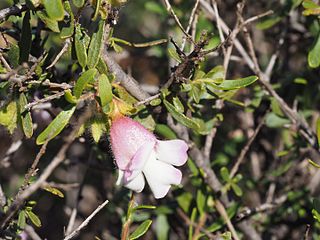
Eremophila dichroantha, also known as bale-hook eremophila, is a flowering plant in the figwort family, Scrophulariaceae and is endemic to the south-west of Western Australia. It is a shrub with many ascending branches making the plant appear broom-like. It has small, hooked leaves and small, though abundant, violet to lilac-coloured flowers.
Eremophila appressa, commonly known as wispy poverty bush, is a plant in the figwort family, Scrophulariaceae and is endemic to two remote locations in the central west of Western Australia. Its most unusual feature is its leaves which, at least when young, are less than 2.5 mm (0.1 in) long and 1 mm (0.04 in) wide and are glued to the stem by resin.

Eremophila complanata is a flowering plant in the figwort family, Scrophulariaceae and is endemic to a small area in the south west of Western Australia. It is an erect shrub with narrow, flattened leaves and hairy pink flowers which are also distinctly flattened.

Eremophila compressa is a flowering plant in the figwort family, Scrophulariaceae and is endemic to a small area in the south west of Western Australia. It is an erect shrub whose leaves have 2 or 3 prominent teeth near their ends, and white or cream-coloured flowers.
Eremophila grandiflora is a flowering plant in the figwort family, Scrophulariaceae and is endemic to Western Australia. It is a large shrub with shiny leaves and the largest flowers in its genus and is only known from a restricted area near Paynes Find.

Eremophila incisa is a flowering plant in the figwort family, Scrophulariaceae and is endemic to Western Australia. It is a low shrub with shiny leaves which have thickened teeth along their edges and hairy, mauve or purple flowers.
Eremophila pendulina is a flowering plant in the figwort family, Scrophulariaceae and is endemic to Western Australia. It is a tall, spindly, weeping shrub with narrow leaves and purple, mauve or white flowers in autumn and early spring.
Eremophila prolata is a flowering plant in the figwort family, Scrophulariaceae and is endemic to Western Australia. It is an erect shrub with a rounded top, prominently ridged, hairy branches, narrow leaves and white to deep lilac-coloured flowers.

Eremophila rugosa is a flowering plant in the figwort family, Scrophulariaceae and is endemic to Western Australia. It is an erect shrub with sticky, shiny leaves and pink, purple or mauve flowers.
Eremophila setacea is a flowering plant in the figwort family, Scrophulariaceae and is endemic to Western Australia. It is an erect shrub with narrow, glabrous leaves, hairy sepals and light blue to purple petals.

Eremophila spinescens is a flowering plant in the figwort family, Scrophulariaceae and is endemic to Western Australia. It is a low, spreading, rigid, spiny shrub with small leaves and lilac to dark purple flowers.
Eremophila succinea is a flowering plant in the figwort family, Scrophulariaceae and is endemic to Western Australia. It is an erect, broom-shaped shrub with sticky, narrow, hooked leaves, narrow, sticky sepals and hairy, pale purple or mauve petals.
Eremophila tenella is a flowering plant in the figwort family, Scrophulariaceae and is endemic to Western Australia. It is an erect, spindly shrub with pendulous branches and with its branches and leaves covered with a layer of fine, branched, yellow-grey hairs. Its buds are yellowish but open to white or pale lilac flowers.

Eremophila willsii is a flowering plant in the figwort family, Scrophulariaceae and is endemic to Australia. It is an erect shrub with bright green, often serrated leaves and pinkish to deep pinkish-purple petals. It is mainly found in Western Australia, the Northern Territory and South Australia in deep sand.
Eremophila buirchellii is a flowering plant in the figwort family, Scrophulariaceae and is endemic to the Mount Augustus National Park in Western Australia. It is an erect shrub with densely clustered leaves, pink, bell-shaped flowers and with most parts of the plant covered with greyish, branched hairs.
Eremophila ballythunnensis is a flowering plant in the figwort family, Scrophulariaceae and is endemic to Western Australia. It is a small, spreading shrub with narrow oval leaves and mauve-purple flowers with densely hairy sepals.
Eremophila capricornica is a flowering plant in the figwort family, Scrophulariaceae and is endemic to Western Australia. It is a small shrub with woolly branches, grey, hairy leaves and mauve to lilac-coloured flowers with hairy sepals.
Eremophila hamulata is a flowering plant in the figwort family, Scrophulariaceae and is endemic to Western Australia. It is an erect, woody shrub with sticky branches, narrow, hooked leaves and hairy mauve-purple flowers.
Eremophila jamesiorum is a flowering plant in the figwort family, Scrophulariaceae and is endemic to Western Australia. It is a wispy, sticky shrub with narrow linear leaves and white flowers tinged with pink or mauve. It is only known from a few locations in the Gibson Desert.
Eremophila subangustifolia is a flowering plant in the figwort family, Scrophulariaceae and is endemic to the south-west of Western Australia. It is a highly branched shrub which produces a slightly unpleasant odour and has its younger parts densely covered with greyish hairs. The leaves are scattered along the branches and the mostly white flowers are borne singly in leaf axils. It only occurs in a small area near Eneabba and had previously been known as E. microtheca subsp. 'narrow leaves'.







